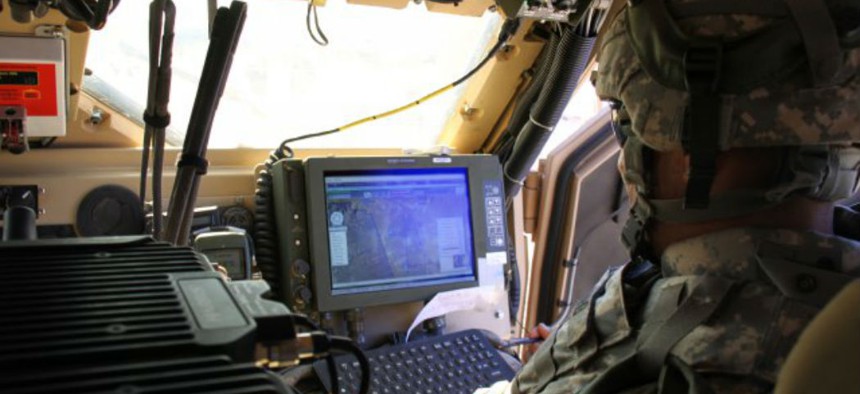Army evaluates vehicle-mounted software programmable radio
Mid-Tier Networking Vehicular Radio is designed to better connect ground combat vehicles on the move in a SatCom denied environment.
The Army is evaluating a new vehicle-mounted radio technology that enables Strykers, tactical trucks, HMMWVs and Mine Resistant Ambush Protected vehicles to share real-time, combat-relevant information across the force.
The new radios, called the Mid-tier Networking Vehicular Radio, were recently assessed in various combat scenarios such as rugged, mountainous terrain, woodland areas and dense vegetation to test its ability to relay IP packets of information through various high-bandwidth waveforms, service officials said.
Software programmable radio is designed to permit sharing mission command tactical information even if satellite systems are disabled. The mid-tier network assessment utilized approximately 85 MNVR radios to provide voice, data and connectivity from one operational battalion to brigade, said Paul Mehney, former Communication Director for Program Executive Office Command, Control and Communications.
The MNVR, made by the Harris Corp., uses NSA certified encryption for additional safety and protection. It integrates into vehicles on-the-move in combat to transmit voice, pictures and data.
With software programmable radio, each device functions as both a radio and router able to wirelessly transmit information through several government-owned high-bandwidth radios. Some of these waveforms include Soldier Radio Waveform and Wideband Networking Waveform engineered to send IP packets, pictures and data across the force without needing a fixed infrastructure such as a cell tower or satellite.
If anti-satellite weapons destroyed or disabled a U.S. satellite, SatCom communication could be compromised or destroyed. In this situation, operational forces in combat would still need to communicate location, tactical information and various command and control details while on-the-move on the battlefield.
Potential rivals, such as China, are known to be developing what is called ASAT, or anti-satellite, weapons designed for that purpose. As a result, Army engineers, scientists and experts have been working vigorously on developing technologies able to function in what’s called a “SatCom denied” environment.
This is new technology is important because the well-known and widely used force-tracking technology, called Blue Force Tracker, relies upon satellites to provide icons on a digital map displaying combat, terrain and force-tracking information.
The new high-bandwidth radios are able to operate in what’s called a “beyond-line-of-sight” environment where mountains, weather or terrain might otherwise obscure communications.
The wideband waveform brings the ability to transmit voice, data and video in difficult terrain or where there is a lack of SatCom. It provides you a mobile cell tower, but through radio waveforms instead of satellite, Mehney added.
The combat scenarios were executing during a regular Army event called the Network Integration Evaluation at White Sands Missile Range, N.M.
The Network Integration Evaluation, or NIE, included approximately 2,000 soldiers from the 2nd Brigade Combat Team, 1st Armored Division performing Combined Arms Maneuver missions over more than 1,062 square miles.
The MNVR is slated to field by 2018 and 2019, officials said.





